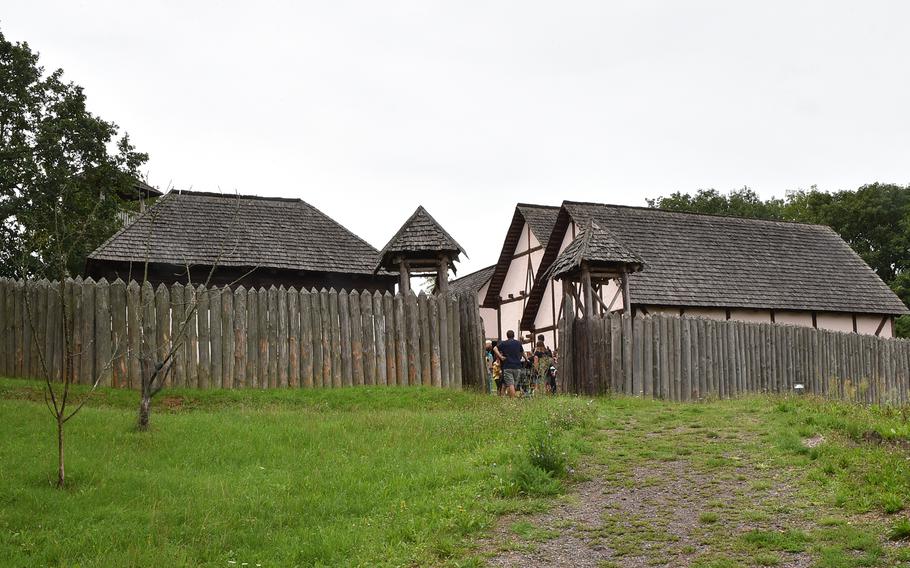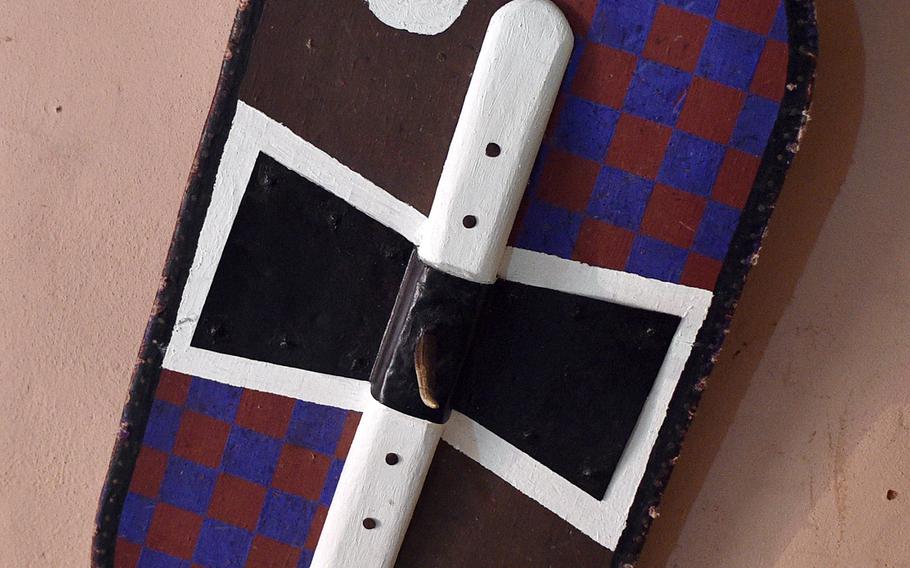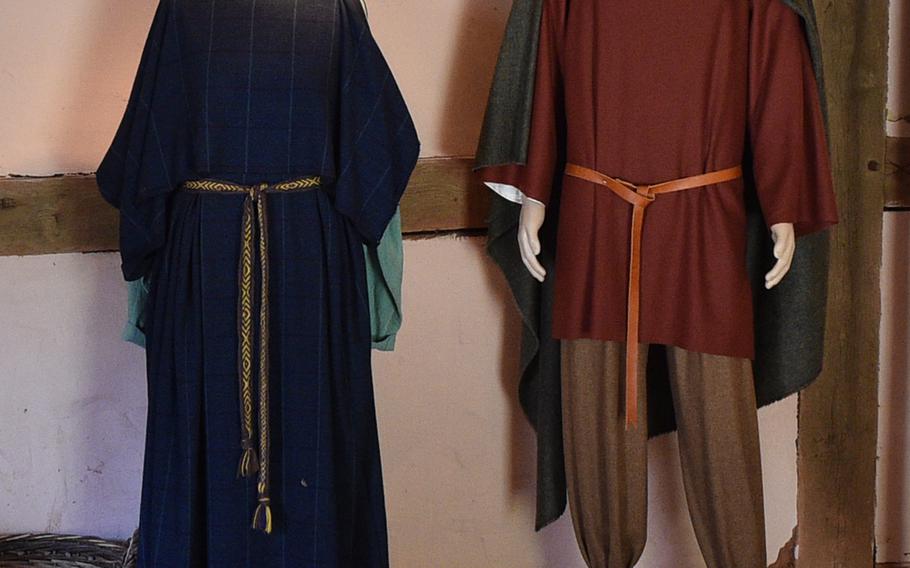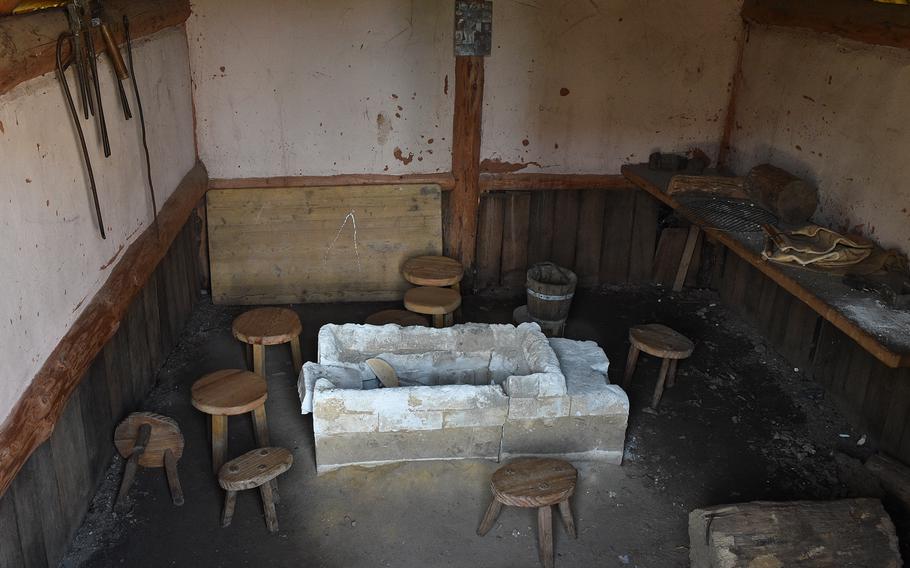
The watchtower at the Keltendorf am Donnersberg in Steinbach am Donnersberg, Germany, offers this view of the replica Celtic village. Visitors can take a village tour, which ends with a drink: mead for adults and apple juice for children. (Matt Wagner/Stars and Stripes)
Getting off the A63 highway at the Goellheim exit on my drive home from Kaiserslautern, Germany, I kept seeing signs for a Keltendorf, or Celtic village, which piqued my curiosity.
Research told me that it’s a replica village in Steinbach am Donnersberg meant to teach visitors about the ancient Celts, a group normally associated with the British Isles and the salt mines of Hallstatt, Austria.
At its height, their influence stretched from western France and the Iberian Peninsula to Eastern Europe in the latter centuries B.C.

The gate of the Keltendorf am Donnersberg in Steinbach am Donnersberg, Germany, is seen on Aug. 13, 2023. The replica Celtic village was built in 2003. (Matt Wagner/Stars and Stripes)
In the Pfalz region of Germany, signs of Celtic settlements and tribes have been found around Donnersberg, the highest peak in the area. A sign in the ticket office explained how a late-Celtic fortified settlement had been excavated on the mountain.
According to information at the village, though, that nearly 100-acre settlement didn’t serve as the model for the Steinbach attraction.

A shield hangs inside a building at the Keltendorf am Donnersberg in Steinbach am Donnersberg, Germany. The replica village was based on structures excavated near Germersheim. (Matt Wagner/Stars and Stripes)
Instead, the buildings were based on a settlement discovered near Germersheim by the Rhine River, where at least five timbered buildings and two wells have been found.
Visitors can walk around the replica village freely, but I stumbled on the start of an approximately one-hour tour in German and followed along.
The guide seemed knowledgeable on the subjects, even if I didn’t catch everything he was saying because of my still-rough grasp of German.

These displays at the Keltendorf am Donnersberg in Steinbach am Donnersberg, Germany, show replicas of Celtic clothing. (Matt Wagner/Stars and Stripes)
It was interesting to see representations of Celtic life and hear about it. I appreciated details such as the length of time it took them to make a tunic (a year), as well as the commentary on the buildings and Celtic metalwork.
A lot of the information is secondhand, as told through Roman accounts and archaeological finds.
The tour ended with a drink: apple juice for the youngsters and mead for the adults. It was a nice way to cool off on a warm day.

The forge at Keltendorf am Donnersberg in Steinbach am Donnersberg, Germany. Up to the 7th century B.C., the Celts had mastered the techniques to forge bronze and iron, according to a sign at the replica village. (Matt Wagner/Stars and Stripes)
Visitors also may tour a crafts building, where they can work with leather and felt and make such things as arrows or a stone pearl.
A 38-foot-tall watchtower in the village also gives great views of Donnersberg and the areas to the south and east.
For groups, half-day and full-day programs during the week are offered. The programs include the usual offered crafts, archery, Celtic fairy tales, weaving with wool, crafting with natural materials, copperwork, herb hunt and processing, food at an extra cost and fire making, for those 10 years and older.
On the QT
Address: Bruehlstrasse, 67808 Steinbach am Donnersberg, Germany
Times: Open 11 a.m.-4 p.m. every Sunday and holiday through Oct. 31; group programs are available from Monday to Saturday by request. Closed for the winter from Nov. 1 into late March 2024.
Cost: 7 euros for adults, 5 euros for kids ages 4 to 12 and 19 euros for families (two adults and their children). Group rates and half- or whole-day programs also are available.
Information: Phone: +49 63521712; Online: keltendorf-steinbach.de